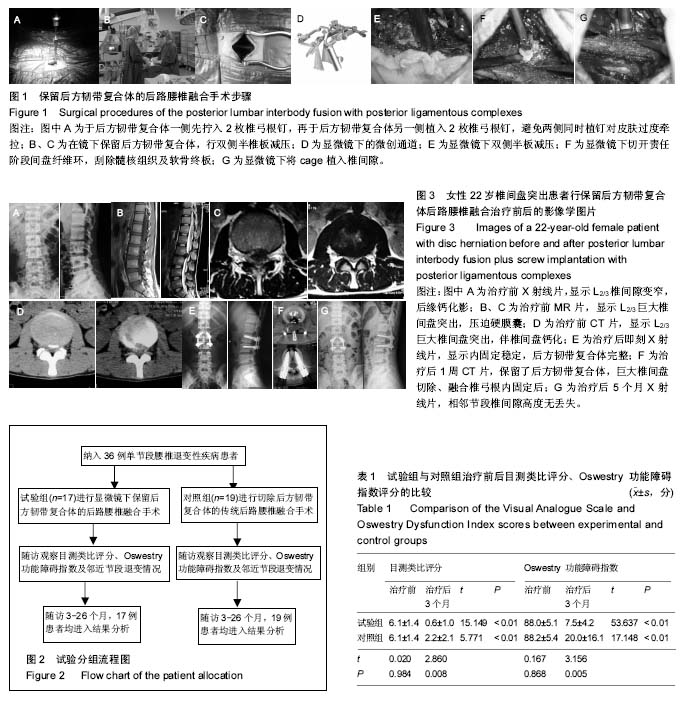| [1] Cloward RB.Spondylolisthesis: treatment by laminectomy and posterior interbody fusion.Clin Orthop Relat Res. 1981; (154):74-82.[2] Shriver MF,Lubelski D,Sharma AM,et al.Adjacent segment degeneration and disease following cervical arthroplasty: a systematic review and meta-analysis.Spine J.2016;16(2): 168-181.[3] Virk SS,Niedermeier S,Yu E,et al.Adjacent segment disease. Orthopedics.2014;37(8):547-555.[4] Nakashima H,Kawakami N,Tsuji T,et al.Adjacent Segment Disease After Posterior Lumbar Interbody Fusion: Based on Cases With a Minimum of 10 Years of Follow-up.Spine(Phila Pa 1976).2015;40(14):E831-841.[5] St-Pierre GH,Jack A,Siddiqui MM,et al.Nonfusion Does Not Prevent Adjacent Segment Disease: Dynesys Long-term Outcomes With Minimum Five-year Follow-up.Spine(Phila Pa 1976).2016;41(3):265-273.[6] Xia XP,Chen HL,Cheng HB.Prevalence of adjacent segment degeneration after spine surgery: a systematic review and meta-analysis.Spine(Phila Pa 1976).2013;38(7):597-608.[7] Ren C,Song Y,Liu L,et al.Adjacent segment degeneration and disease after lumbar fusion compared with motion-preserving procedures: a meta-analysis.Eur J Orthop Surg Traumatol. 2014;24:245-253.[8] Goel VK,Kim YE,Lim TH,et al.An analytical investigation of the mechanics of spinal instrumentation.Spine. 1988;13(9): 1003-1011.[9] Moskowitz A.Transforaminal lumbar interbody fusion.Orthop Clin North Am.2002;33(2):359-366.[10] Liu H,Wu W,Li Y,et al.Protective effects of preserving the posterior complex on the development of adjacent-segment degeneration after lumbar fusion.J Neurosurg Spine. 2013; 19(2):201-206.[11] Lai PL,Chen LH,Niu CC,et al.Relation between laminectomy and development of adjacent segment instability after lumbar fusion with pedicle fixation.Spine(Phila Pa 1976).2004;29(22):2527-2532. [12] Ekman P,Möller H,Shalabi A,et al.A prospective randomised study on the long-term effect of lumbar fusion on adjacent disc degeneration.Eur Spine J.2009;18(8): 1175-1186.[13] Kim HJ,Kang KT,Moon SH,et al.The quantitative assessment of risk factors to overstress at adjacent segments after lumbar fusion: removal of posterior ligaments and pedicle screws.Spine(Phila Pa 1976).2011; 36(17):1367-1373.[14] Chen BL,Wei FX,Ueyama K,et al.Adjacent segment degeneration after single-segment PLIF: the risk factor for degeneration and its impact on clinical outcomes.Eur Spine J.2011;11:1946-1950.[15] Wai EK,Santos ER,Morcom RA,et al.Magnetic resonance imaging 20 years after anterior lumbar interbody fusion.Spine(Phila Pa 1976).2006;31(17):1952-1956.[16] Chen CS,Feng CK,Cheng CK,et al.Biomechanical analysis of the disc adjacent to posterolateral fusion with laminectomy in lumbar spine.J Spinal Disord Tech.2005; 18(1):58-65.[17] Chen LH,Lai PL,Tai CL,et al.The effect of interspinous ligament integrity on adjacent segment instability after lumbar instrumentation and laminectomy-an experimental study in porcine model.Biomed Mater Eng.2006;16: 261-267.[18] Tai CL,Hsiesh PH,Chen WP,et al.Biochemical comperison of lumbar spine instability between laminectomy and bilateral laminotomy for spinal stenosis syndrome-an experimental study in porcine model.BMC Musculoskelet Disord.2008; 11:84.[19] Kato Y,Punjabi M,Nibu K.Biochemical study of lumbar spinal stability after osteoplastic laminectomy.J Spinal Disord.1998; 11:146-150.[20] Arnoldi CC,Brodsky AE,Cauchoix J,et al.Lumbar spinal stenosis and nerve root entrapment syndromes: Definition and classification.Clin Orthop Relat Res.1976;115:4-5. [21] Verbiest H.Results of surgical treatment of idiopathic developmental stenosis of the lumbar vertebral canal; Areview of twenty-seven years experience.J Bone joint Surg Br.1977;59(2):181-188.[22] Turner JA,Ersek M,Herron L,et al.Surgery for lumbar spinal stenosis: attempted meta-analysis of the literature.Spine(Phila Pa 1976).1992;17(1):1-84. [23] Atlas JA,Deyo RA,Keller RB,et al.The Maine lumbar spine study Part III: 1 year outcomes of surgical and nonsurgical management of lumbar spinal stenosis.Spine(Phila Pa 1976). 1996;21:1787-1795. [24] Thomas NW,Rea GL,Pikul BK,et al.Quantitative outcome and radiographic comparisons between laminectomy and laminotomy in the treatment of acquired lumbar stenosis. Neurosurgery.1997;41:567-575.[25] Postacchini F,Cinotti G,Perugia D,et al.The surgical management of central lumbar stenosis: multiple laminotomy compared with total laminectomy.J Bone Joint Surg Br.1993; 75(3):386-392.[26] Johnson B,Annertz M,Sjoberg C,et al.A progressive and consecutive study of surgically treated lumbar spinal stenosis.Part II; Five year follow-up by an independent observer.Spine(Phila Pa 1976).1997;22:2938-2944. [27] Johnson B,Annertz M,Sjoberg C,et al.A progressive and consecutive study of surgically treated lumbar spinal stenosis.Part I: Clinical features related to radiographic findings.Spine(Phila Pa 1976).1997;22:2932-2937. [28] Shenkin HA,Hash CJ.Spondylolisthesis after multiple bilateral laminectomies and facetectomies for lumbar spondylosis. Follow-up review.J Neurosurg.1979;50:45-47. [29] Lee CK.Lumbar spine instability (olisthesis) after extensive posterior spinal decompression.Spine(Phila Pa 1976).1983;8: 429-432.[30] Arnoldi CC,Brodsky AE,Cauchoix J,et al.Lumbar spinal stenosis and nerve root entrapment syndromes: Definition and classification.ClinOrthopRelat Res.1976;115:4-5. [31] Wang J,Zhou Y,Zhang ZF,et al.Minimally invasive or open transforaminal lumbar interbody fusion as revision surgery for patients previously treated by open discectomy and decompression of the lumbar spine.Eur Spine J.2011;20: 623-628. [32] Tian NF,Wu YS,Zhang XL,et al.Minimally invasive versus open transforaminal lumbar interbody fusion: A meta-analysis based on the current evidence.Eur Spine J.2013;22: 1741-1749. [33] Goldstein CL,Macwan K,Sundararajan K,et al.Comparative outcomes of minimally invasive surgery for posterior lumbar fusion: A systematic review.Clin Orthop Relat Res.2014;472: 1727-1737. [34] Pan L,Zhang P,Yin Q.Comparison of tissue damages caused by endoscopic lumbar discectomy and traditional lumbar discectomy: A randomised controlled trial.Int J Surg.2014;12: 534-537. [35] Wang J,Zhou Y,Feng Zhang Z,et al.Comparison of the clinical outcome in overweight or obese patients after minimally invasive versus open transforaminal lumbar interbody fusion. J Spinal Disord Tech.2014;27:202-206.[36] Evaniew N,Khan M,Drew B,et al.Minimally invasive versus open surgery for cervical and lumbar discectomy: a systematic review and meta-analysis.CMAJ Open.2014;2(4): E295-305. |
.jpg)

.jpg)